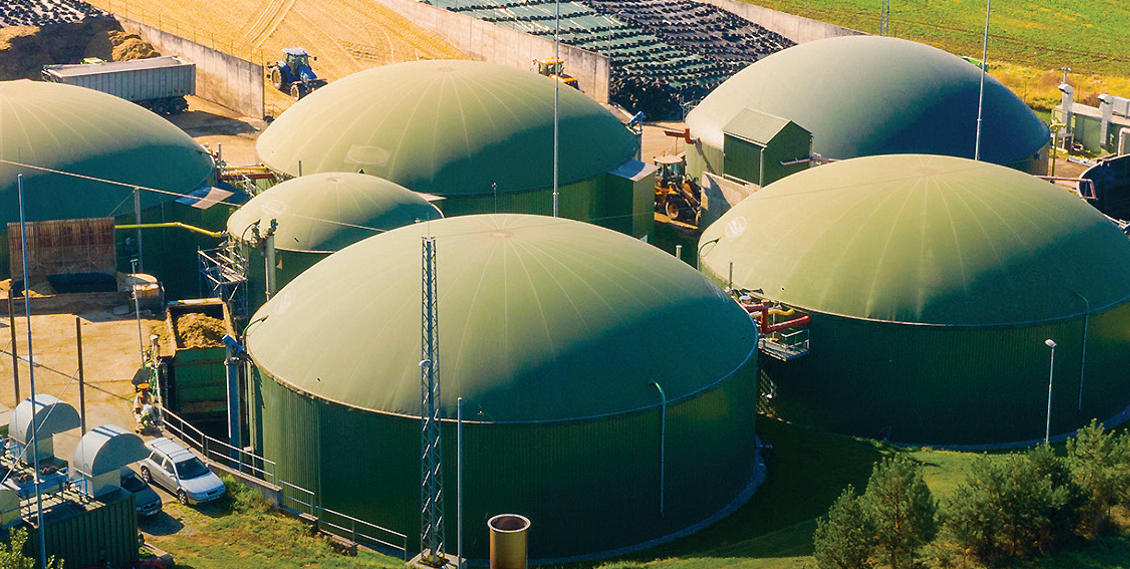Biomethane

Biomethane, otherwise known as renewable natural gas (RNG), is a purified form of biogas. Biogas is produced by anaerobic decomposition of organic matter and its main energy carrier is methane. The removal of impurities upgrades biogas to a quality standard applicable to requirements for group E high-methane gaseous fuel known as biomethane. Its properties are similar to natural gas. This means that biomethane can be used in the existing gas infrastructure as an environmentally friendly substitute for fossil fuels.
Biomethane production process consists of several stages:
- Anaerobic digestion – organic raw materials (substrates) such as agricultural and food waste, manure or sewage sludge are fed into bioreactors. Under anaerobic conditions, microorganisms break down the organic matter, producing biogas containing, among others, methane and carbon dioxide.
- Biogas purification – raw biogas contains approx. 50-70% methane as well as admixtures of other gases. The purification process involves removing undesirable compounds such as carbon dioxide and hydrogen sulphide. Biogas is also dried to remove water vapour, and biomethane is ready.
- Transport and use – biomethane can be injected directly into the gas network. After compression to bioCNG or its liquefaction to bioLNG, it can also be transported by road. Depending on the demand and the form of transport, it can be used in various sectors of the economy, including energy generation and transport.
Biogas:
At a time when we are pursuing climate neutrality and independence from imported natural gas, biomethane is becoming a strategically important fuel for Europe. It is a renewable, local and flexible source of energy, perfectly aligned with the principles of green transition.
- Produced by the anaerobic digestion of biomass, organic waste or manure.
- Consists mainly of methane (50-70%) and carbon dioxide (30-50%), but also contains trace amounts of hydrogen sulphide, water vapour and other impurities.
- Primarily used locally, usually in cogeneration plants that produce electricity and heat. Although this solution is effective on a small scale, it is highly dependent on heat demand in the immediate vicinity. When local consumption is low, surplus energy is not fully utilised.
- Refined biogas – with CO2 and other compounds removed, it achieves a quality almost identical to natural gas (approx. 97-99% methane).
- With parameters comparable to natural gas, it can be injected directly into the existing gas network. This means that energy can be transported on a regional, national and even international scale – to places where it is actually needed.
- Can be transported and used even at a considerable distance from its production site, which allows for more efficient use and significantly increases the market value of the product. While there are quite a few restrictions on the sales potential of biogas, biomethane can be certified as a renewable fuel and its green origin is increasingly valued by industry and the transport sector.
- It aligns perfectly with the objectives of the EU climate policy, including the RED II Directive and the Fit for 55 package. Its production and consumption support reduction of emissions in hard-to-decarbonise sectors, such as heavy-duty transport and chemical industry.
At a time when we are pursuing climate neutrality and independence from imported natural gas, biomethane is becoming a strategically important fuel for Europe. It is a renewable, local and flexible source of energy, perfectly aligned with the principles of green transition.
In the era of energy transition and the search for low-carbon energy sources, renewable fuels are gaining increasingly more attention. Biomethane opens up new opportunities for industry as well as transport and energy sectors.
Biomethane provides a number of benefits:
According to data from the Ministry of Climate and Environment, the potential for biomethane production in Poland is approx. 8 bcm/y. Considering that the domestic demand for natural gas fluctuates between 18 and 20 bcm/y, biomethane could satisfy part of it, contributing to energy security and achieving climate objectives.
The large-scale use of biomethane will require transport to customers spread over different locations. Read more how biomethane plants can be connected to the GAZ-SYSTEM transmission network.
Biomethane provides a number of benefits:
- Reduction of greenhouse gas emissions – biomethane combustion emits carbon dioxide that has been previously absorbed by plants, which means zero net CO2 emissions.
- Waste utilisation – biomethane production allows effective management of organic waste, contributing to a circular economy.
- Energy independence – the use of local raw materials for biomethane production reduces dependence on fossil fuel imports.
- Compatibility with the existing infrastructure – biomethane can be used in the existing gas installations which facilitates its integration and reduces implementation costs.
According to data from the Ministry of Climate and Environment, the potential for biomethane production in Poland is approx. 8 bcm/y. Considering that the domestic demand for natural gas fluctuates between 18 and 20 bcm/y, biomethane could satisfy part of it, contributing to energy security and achieving climate objectives.
The large-scale use of biomethane will require transport to customers spread over different locations. Read more how biomethane plants can be connected to the GAZ-SYSTEM transmission network.
